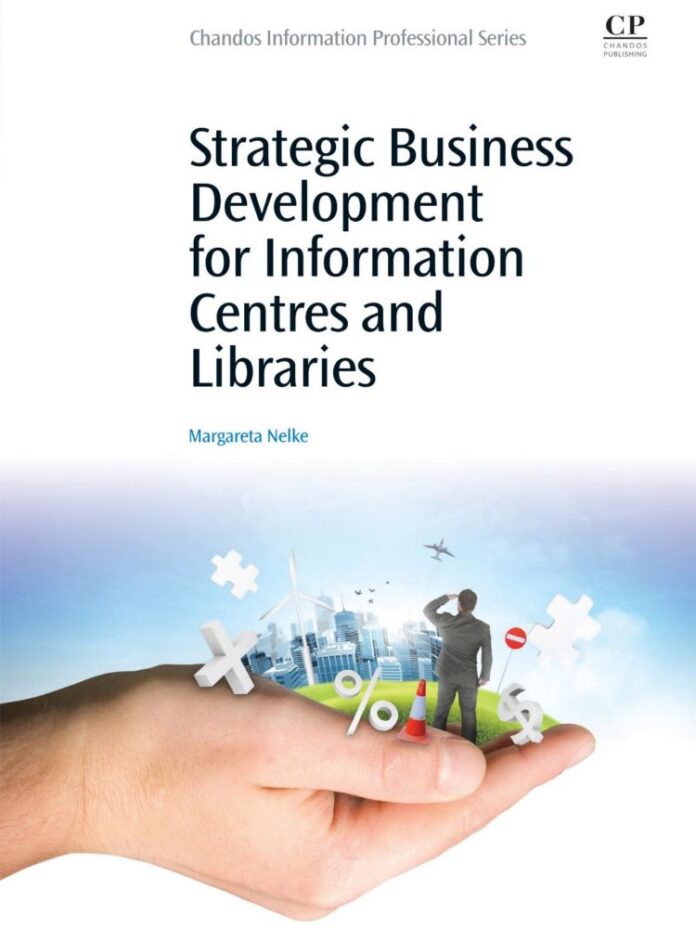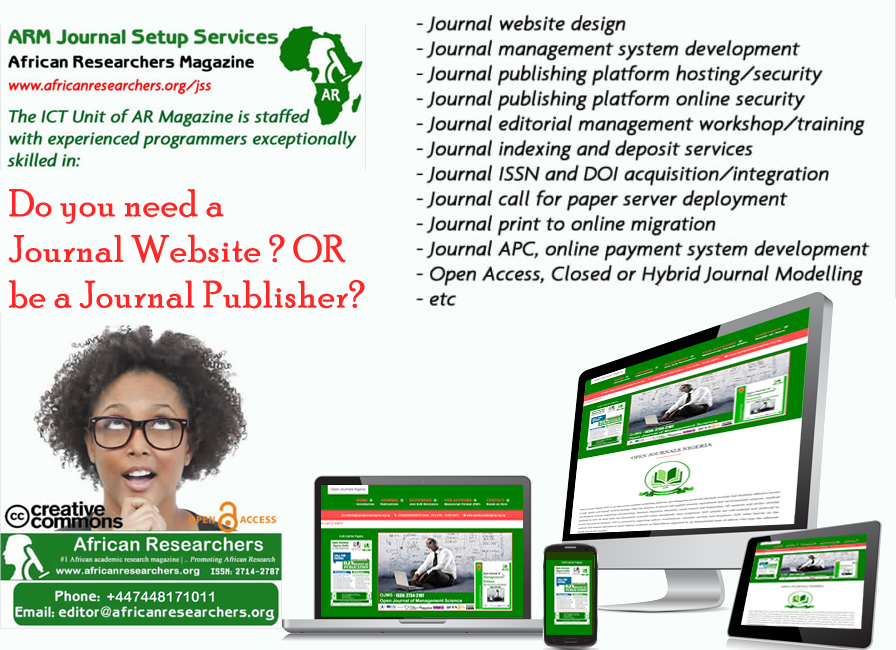The book, Strategic Business Development for Information Centres and Libraries, was authored by Margareta Nelke. The book comprises 172 pages (ISBN: ISBN: 978–1–84334–661–6) written in English and published by Candos Publishing in the United Kingdom in 2012.
The book provides a nine (9) chapter summarization of the place of strategic business development in libraries and information centres. As identified by author, Margareta Nelke, she argues that, business development is essential for all business; not least the library and information service (LIS) sector. To work with strategic business development is particularly essential to ensure a viable future business that provides benefits to customers and stakeholders.
Chapter 1 of this book examines the necessary business development and planning. In this chapter, the author explains that, strategic business development and planning are the focus of this book. This chapter provides insights regarding what library and information managers should know concerning business development. In so doing, the author states that strategic business development is characterised by its long-term perspective and its focus on the direction of the business rather than by concrete action plans. According to Margareta, the purpose of strategic business development is to ensure that the business delivers value and benefits for the parent organisation. The book describes the process of developing the business and the business plan, and the important work that should precede the formulation of the strategic business plan.
Chapter 2 of this book focuses on leadership and change management. The author believes that, equipping organisations for change is one of the most important motives for strategic business development. Adding that, leaders and team members have responsibility to participate in the development process and to promote the business to the key stakeholders and to the users. The author in this chapter submits that, manager’s main responsibility is to make sure that the aim of the business and the way it is fulfilled contribute to the parent organisation’s mission and goals. Networking and building alliances as well as promoting the business and making it visible are also important responsibilities. According to Margarata, the team members have, besides their ordinary duties, important responsibilities to collaborate in business development, to make sure that their own professional development is proceeding and to contribute to promotion of the business. To involve staff in development and planning is a key factor to success; however, the timing for the involvement should be carefully chosen and it is particularly important in times of budget restrictions and other major changes to have an involved and engaged staff.
Chapter 3 is on competitive intelligence. The author conceptualizes that, competitive intelligence is the continuous and systematic monitoring and analysing of what is happening in our business environment and how it influences and impacts business. From the book, it is an essential activity, not least for strategic and long-term business development. In view of the author’s disposition, competitive intelligence is best done as teamwork to ensure that different views and perspectives are included. According to Margarata, the work can be organised as a process following the intelligence cycle PCMAC – plan and prioritise, capture, manage, analyse and communicate. The first phase – plan and prioritise – is of crucial importance for the success of the activity as a whole. In this phase, we answer the questions why we do it, which business processes and decisions the intelligence is to support, for whom we do it, and which key intelligence topics and questions we should monitor and analyse.
In Chapter 4, which focuses on business concepts and information strategies, the author thinks that there is a need for strategic planning and professional management of such an important and valuable asset as information. This is because corporations and organisations lose large sums annually due to deficits in information management. Furthermore, the author upholds that, the strategic business development and planning entail the formulation of the business concept, setting down the information strategies and the long-term goals, and the formulation of strategies for implementation, evaluation and follow-up. Also, the author is of the opinion that, business concept is an important part, which consists of the formulation of vision, goals and the commission, to identify the stakeholders, to investigate and map the needs, to formulate a value proposition to confirm which benefits and value the LIS function delivers to the parent organisation, to analyse the consequences and risks, and to prioritise among the alternatives.
Chapter 5 of this book which is entitled, the business plan, concludes that strategic business plan is the visible outcome of strategic business development. This chapter states that, even if there is a standardised form to be used for the plan, it is important to see it as a tool for business development and not just a form to be filled in. The author sees business plan is also a good tool for promoting the business and making it visible. The important elements of the business plan are listed in the book as identified by the author. While examining this chapter, the author states that there is an annual process for drawing up the business plan and an example of this process is described, starting with formulating the business concept and ending with the presentation and discussion of the plan with the key stakeholders.
Going further, Chapter 6 explores the strategic goals, measurement and evaluation for business. In so doing, the author states that the goals should be SMART (specific, measurable, achievable, realistic and time-related). Adding that, the goals set must be measured and evaluated by appropriate qualitative or quantitative measurement methods. The author emphasizes that, when doing this we must look out for pitfalls such as measuring only what is easy to measure or being obsessed by statistics and quantitative metrics. In this chapter, it was noted that, continuity is necessary for measurements and evaluation as we want to catch changes in performance from one year to another.
Also, Chapter 7 discusses the implementation of strategic decisions. From the book, the author reveals that the implementation of strategic decisions resulting in major changes must be prepared carefully to be successful. For example, changes in the service offerings could be questioned by users and other key stakeholders; therefore, the author submits that it is important that the senior management understands and agrees with the forces behind the change. The author adds that, it is also important to communicate the changes in a good way and to ensure that the timing of the implementation is as optimal as possible. The author also describes how changes derived from the business development process and how they were implemented.
Furthermore, in Chapter 8 which is entitled, tools, the author describes some methods which can be used in many contexts, for example in competitive intelligence, for the prioritisation of services, for general business development and for evaluation. The author in this chapter submits that when working with business development and planning there are some tools which can be useful in the process. These tools can also be used in other contexts. Tools for brainstorming, analysis and visualizing are described in detail with the purpose to be of help when organising such activities as identified by the author. However, the author suggests the use of PESTLE-M (Political, economic, social, technological, legal, environmental and media), SWOT (Strength, Weakness, Opportunity and Threat), spider diagram and benchmarking as tools for evaluating business information.
Finally, Chapter 9 discusses the changes and challenges. As impressed by the author, it is believed that, rapid changes occur in the information business and these changes have an impact on the LIS functions. The author argues that, some of the changes we can influence and on other changes we have no influence whatsoever, but we must relate to them in one way or another. As noted by the author, the World Wide Web and the shift to electronic media with the subsequent fast development of new devices and solutions for producing, searching, accessing and delivering information are part of the major changes seen in recent decades. Other changes are commercialisation of metadata, the growing importance of copyright issues for electronic information, the changing role of the information professional, the needs for new competence and increased demand for cooperation and collaboration with stakeholders and colleagues, both within and outside the organization, hence the LIS business continues to strive to be an embedded part of the parent organisation’s business processes. However, the author submits that the challenges of today and for the future are to manage both physical and electronic information resources at the same time, to deliver nicely packaged and compiled information to different platforms, to interact with users and clients, to be an embedded part of the parent organisation’s business processes, to demonstrate visible benefits and value, and to meet increased competition and general economic restrictions.
Throughout this book, Margareta Nelke takes an important step to support the improvement of the strategy work focusing primarily on the LIS sector. The book is excellent for both people who are familiar with working with strategic planning and for the ones not familiar with this. For the accustomed person, the book gives new perspectives, new ideas and a very good systematic review of the field. The unaccustomed person gets comprehensive theories, tips and tools on how the strategy work can be accomplished. The book combines theory with examples from practice, which give a deeper and better understanding of the importance of strategic planning. One section contains a number of tools that create a good basis for the strategic business development. Two important aspects from the book are, on the one hand, the significance of monitoring and analysing the outside world and, on the other hand, to involve all employees in the strategy work.
Summarily, the author submits that, there is need to have a clear picture of the aims of our business, where we are heading and what we must do to achieve our goals. The technology in the world around us is constantly changing, which in turn alters the media we manage as well as the behaviour and expectations of customers. This of course affects the basic conditions for the business, not least in the LIS field.
















 The African Research (AR) Index is a comprehensive scholarly directory and database focused explicitly on journal publishers that publish and disseminate African research.
The African Research (AR) Index is a comprehensive scholarly directory and database focused explicitly on journal publishers that publish and disseminate African research.

